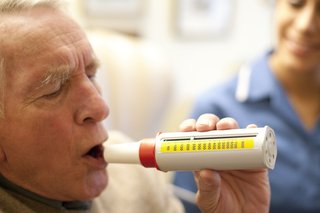Peak flow test
Peak flow is a simple measurement of how quickly you can blow air out of your lungs. It’s often used to help diagnose and monitor asthma.

A peak flow test involves blowing as hard as you can into a small handheld device called a peak flow meter.
These are available:
- On prescription
- To buy direct from most pharmacies
- To purchase online (eg from Amazon.co.uk or other online retailers)
- We have a number of peak flow meters we can give out free of charge to patients who struggle to afford to buy peak flow meters from their pharmacy. Please call us or ask at our reception desk.
Why peak flow is measured
By measuring how fast you’re able to breathe out, your peak flow score can indicate whether your airways are narrowed.
This could be a sign that you have asthma, although other tests such as spirometry will often be needed to confirm the diagnosis.
If you’ve already been diagnosed with asthma, measuring your peak flow regularly can be a useful way of monitoring your condition.
Your score can show whether or not your condition is getting worse. It can also check if your medication is working, and indicate whether you’re having an asthma attack.
Measuring your peak flow before and after exposure to a possible asthma trigger, such as something you’re allergic to or a substance you’re exposed to at work, may also show if anything in particular causes your symptoms.
How to measure your peak flow
The first time your peak flow is measured, you’ll be taught how to do it by a doctor or nurse. After this they may advise you to carry out the test regularly at home using your own peak flow meter.
To measure your peak flow:
- find a comfortable position, either sitting or standing
- reset your peak flow meter so the pointer is pushed back to the first line of the scale – this is usually 60
- hold the peak flow meter so it’s horizontal and make sure that your fingers are not obstructing the measurement scale
- breathe in as deeply as you can and place your lips tightly around the mouthpiece
- breathe out as quickly and as hard as you can
- when you’ve finished breathing out, make a note of your reading
This should be repeated 3 times, and the highest of the 3 measurements should be recorded as your peak flow score.
If you’re monitoring your asthma at home, you may have a diary or chart to record your score. You can download a peak flow diary (PDF, 2.2Mb) from the Asthma UK website if you don’t have one.
Your peak flow score
Your peak flow score – also known as your peak expiratory flow (PEF) – will be displayed on the side of your peak flow meter. This is given in litres of air breathed out per minute (l/min).
What’s considered a normal score depends on your age, height and gender. Ask your GP or asthma nurse for more information on what would be considered a normal score for you.
To help diagnose asthma, your result can be compared to what would usually be expected for someone of your age, height and gender. A significant difference between your score and a normal score, or a difference in your scores in the morning and evening or when your symptoms are good and bad, may suggest you have asthma.
If you’re monitoring your asthma at home, your score should be compared to your best result at a point when your condition was well controlled. A big difference between your current and best score could be a sign that your condition is becoming poorly controlled or that you’re having an asthma attack.


